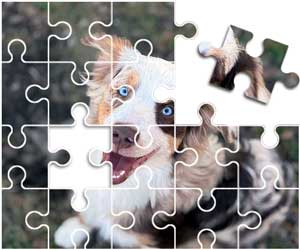
Vestibular Disease in Dogs and What It Means for Your Aussie
Vestibular disease in dogs can be a disturbing issue. The symptoms related to this condition are certainly uncomfortable and can be frightening, but the good news is that it is generally not a very serious condition and will usually clear up on its own within 24-48 hours of onset. Of course, that doesn't make it any easier to see your four-legged friend in such distress but if you understand the causes and symptoms of vestibular disease that should make it easier to handle should it occur in your pet.
When it comes to discussing vestibular disease in dogs treatment is usually the primary concern as you'll want to help rid your pet of the uncomfortable symptoms as quickly as possible. Fortunately, treatment is usually quite easy and in many cases it may not even be necessary as the symptoms often pass on their own.
So what exactly is vestibular disease? This is a condition, also called canine idiopathic vestibular disease or old dog vestibular syndrome, which affects the vestibular system, including the middle and inner ear. The vestibular system is responsible for controlling balance, so vestibular disease in dogs usually manifests with dizziness and the inability to walk properly. That's why it can be so distressing to see a dog suffering from this particular condition.

Aleksandra / stock.adobe.com
It's important to be aware of the causes and symptoms of vestibular disease in dogs so you can get them the treatment they need ASAP.
What Is the Cause of Vestibular Disease in Dogs?
There are various underlying conditions that can cause vestibular disease in dogs, including:
- Ear infection
- Perforated eardrum
- Hypothyroidism
- Trauma
- Tumors
- Side effect from antibiotics
If no underlying cause is detected, the condition will be diagnosed as idiopathic vestibular disease, or old dog vestibular syndrome.
If there is an underlying condition such as an infection or a tumor, then that condition will have to be addressed in order to ease the symptoms of the vestibular disease. That's why with vestibular disease in dogs, treatment can be so varied. That is also why getting your dog examined by a veterinarian is crucial so that you can begin the right path of treatment.
Generally speaking, the symptoms of vestibular disease are most severe within the first twenty-four to forty-eight hours. After that, your dog should begin to spontaneously show signs of improvement. With vestibular disease in dogs, treatment can vary depending on the underlying cause but in most cases, a full recovery will happen within two to three weeks.
Symptoms to Watch for With Vestibular Disease in Dogs
Since vestibular disease in dogs affects the balance, dogs that are affected will show distinct visible symptoms that can come on suddenly and may, on the surface, seem frightening. Common symptoms of vestibular disease include:
- Pronounced head tilt
- Staggering or stumbling
- Nausea or vomiting
- Poor coordination
- Circling in one direction
- Standing with legs spread wide for stability
- Reluctance to eat or drink
- Loss of balance/falling over
- Rapid eye movement while awake
- Choosing to sleep on hard surfaces
Treatment of Vestibular Disease in Dogs
For vestibular disease in dogs treatment is usually individualized depending on the specific circumstances. Most of the symptoms are not painful or dangerous and will usually clear up on their own within one to two weeks. If your dog is experiencing nausea or vomiting, anti-nausea medications can be prescribed to control symptoms.
In some cases, dogs suffering from vestibular disease will experience an inability or a reluctance to drink. In order to ensure proper hydration in these cases, it may be necessary to provide fluids via IV. In more serious cases, hospitalization may be necessary. If the dog is showing an inability to stand or walk properly, a sedative can be prescribed to help calm the dog.
If an ear infection is detected, antibiotics can be prescribed. As the infection clears, the symptoms of vestibular disease in dogs should also spontaneously clear. In cases where a tumor is causing the vestibular disease, it will be necessary to treat the tumor itself in order to ease symptoms.

natalialeb / stock.adobe.com
Vestibular disease in dogs can cause them to lose balance when walking, running, or skateboarding. ;)
With vestibular disease in dogs, treatment is usually limited to keeping your dog comfortable until the symptoms can clear up on their own. Make sure he has a comfortable place to rest, easy access to food and water and that the area surrounding his bed is free from obstacles so that he won't hurt himself when he's unsteady on his feet. You should also block his access to stairs to avoid further injury.
AKA Old Dog Vestibular Syndrome
Because it is more commonly diagnosed in older dogs it also known as old dog vestibular syndrome, however vestibular disease can actually strike at any age and across all breeds. German Shepherds and Doberman Pinschers seem to have a greater risk of developing the condition.
Once again, when it comes to vestibular disease in dogs, treatment is relatively simple and symptoms generally clear up on their own. While not painful or serious, the symptoms can be distressing, especially when they strike in normally active breeds like the Australian Shepherd. It can be upsetting to see your well-coordinated Aussie suddenly unable to stand or walk without help and you should take these symptoms seriously, but there is no reason to panic.
If you notice symptoms of vestibular disease in dogs you should call your vet and schedule an immediate exam. The vet will be able to diagnosis any serious underlying conditions and suggest a proper treatment approach. Also, be aware of the onset and if the symptoms get worse over the first 48 hours, let your vet know immediately. Most importantly, try to remain calm and rest easier knowing that your dog will likely be back to normal before long.
For more information about Aussie health issues see the Australian Shepherd Health & Genetics Institute (ASHGI).
Have Dog Training Questions?
Check out these introductory dog training videos...
I want my dog to stop being aggressive.
I want some help training my new puppy.
I want my dog to stop barking at everything.
Get Australian Shepherd Info, Website Updates, Special Offers, and Cartoons...
FREE GIFT
You'll also receive a free copy of the ebook
My Everyday Dog Training Tools
by professional dog trainer Daniel Abdelnoor, "Doggy Dan"










